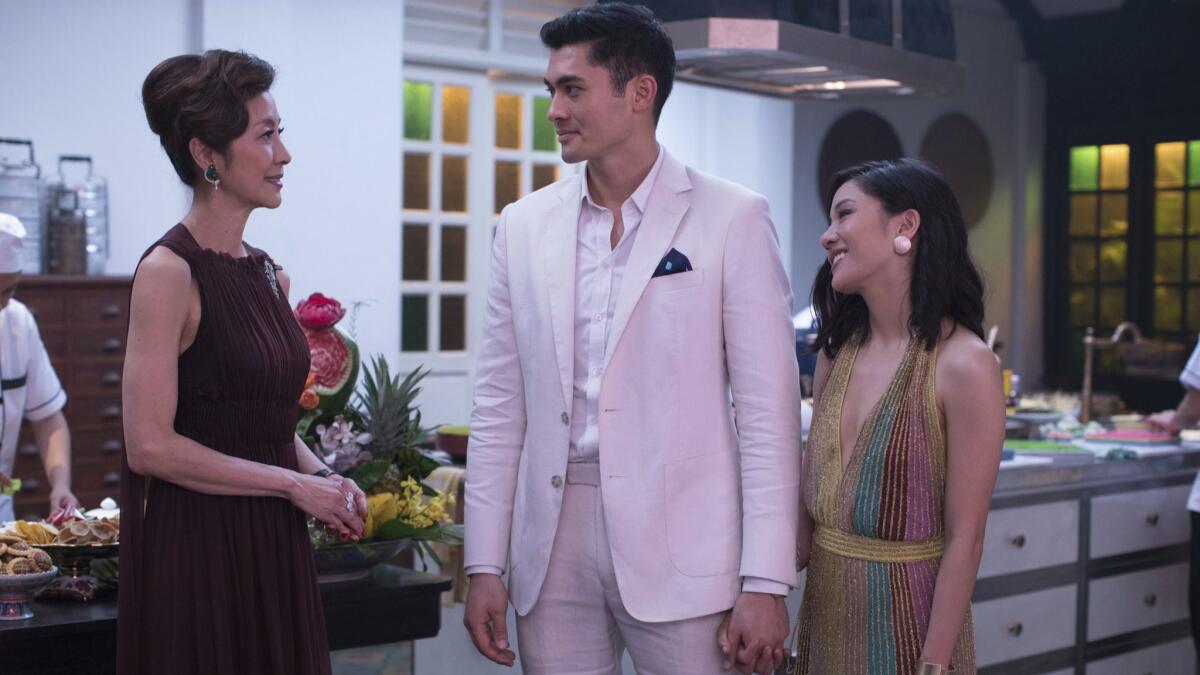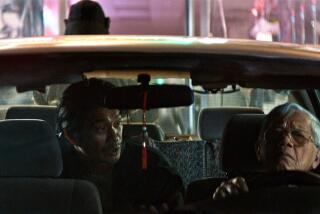At 25, ‘The Joy Luck Club’ is still a captivating Hollywood movie about Asian American identity and, finally, it’s no longer the only one
- Share via
“The Joy Luck Club” is a quadruple-decker melodrama, an incomparable tear-jerker and one of the most resonant immigrant sagas in contemporary American cinema. Shuttling between decades and continents, Wayne Wang’s beloved and acclaimed 1993 adaptation of Amy Tan’s equally beloved bestseller tells the stories of four women born in China before World War II, the four daughters they raise in San Francisco, and the legacies of suffering, shame and perseverance that bind them all.
On my first viewing 25 years ago, however, “The Joy Luck Club” struck me as nothing short of an emotional horror movie, a picture I often found myself watching — and rewatching — through my fingers. Admittedly, I was a squeamish 10-year-old at the time, too young not to recoil from, say, the discreetly framed image of a woman slicing into her own flesh, spilling her blood to prepare a soup for her ailing mother.
The significance of this woman’s act of devotion, rooted in ancient tradition, wasn’t lost on this California kid, no matter how cut off I may have been from my own family’s Shanghai roots. Nor did I fail to grasp its relevance to the film’s oft-repeated central theme, the agonizing sacrifices made by the older generation to provide the liberties their spoiled, carefree Asian American children would enjoy.
For anyone who has lived on either side of that generation gap, there are plenty of cringe-inducing moments in “The Joy Luck Club,” some of which don’t even involve physical mutilation. There’s the scene in which Waverly Jong (Tamlyn Tomita) nervously brings home her white boyfriend to meet her hyper-critical mother, Lindo (Tsai Chin), only to watch as he interrupts the dinner with one ugly Americanism after another. My own parent-mandated music lessons sensitized me to the plight of young June Woo (Melanie Chang) when she plays the piano at a talent show and screws up big time, to the grave disappointment of her mother, Suyuan (Kieu Chinh).
Wang plays up the squirmy humor of these moments in a way that never feels like comic relief because the feelings in this movie are never relieved; they are twisted, deepened, pushed past the point of bearability. “The Joy Luck Club” can be as stirring, and smothering, as a group hug, but it is first and foremost a movie of pitiless emotional violence. In the uniquely fraught world of immigrant parent-child relationships, tenderness and ruthlessness go hand-in-hand.
Twenty-five years later, this two-hour-plus buffet of wartime horror, parental abandonment, sexual assault, serial adultery, suicide, filicide and epically failed marriages (and that’s just the China part!) has lost little of its power to make an audience cry — and cry and cry and cry. Does that make it a great movie? Truth be told, there are moments in the film when I’m not entirely sure it’s a good one. It’s a shamelessly effective contraption, a thing of precision-tooled catharsis.
Each story ends with a flurry of prepackaged little epiphanies, doled out as neatly as red envelopes at a Lunar New Year banquet. The swooning attempts at storybook lyricism — the swan-feather imagery, the flute-heavy dirge of a score — strike an uncanny balance of irritating and irresistible. The symbolism is even worse; witness the vase of flowers that crashes to the floor in slo-mo during a marital spat. (“This is a house that will break into pieces,” someone notes helpfully.)
Here was a movie that allowed Asians and Asian Americans to feel seen in a way that Hollywood had never allowed them before.
— Times film critic Justin Chang
Did I mention that I love this movie anyway? That it’s still a thrill to watch fierce young women like An-Mei (Yi Ding) and Lindo (played as a teenager by Irene Ng) rise up against their families and the viciously repressive patriarchies they represent? That it contains not one but two of the most wrenching cinematic depictions of a mother losing her child I’ve ever seen? That the story of An-Mei’s daughter, Rose — played by Rosalind Chao with a breathtaking meld of boldness and self-doubt — remains a singularly moving portrait of a woman’s struggle for respect?
Yet to love this movie is to mock it. My college friends and I used to quote the screenplay endlessly and appreciatively, varying our references depending on the occasion. We loved mimicking the delightfully brusque Lindo when she snaps, “This best way. That my thinking.” In a sappier mood, we’d echo Suyuan when she gives the now grown-up June (Ming-Na Wen) the teariest postprandial pep talk in movie history: “Waverly took best-quality crab, you took worst … ” (wait for it) “ … because you have best-quality heart!”
Imitating these characters’ thickly accented English was, of course, our way of poking affectionate fun at the Asian elders in all our lives. But it was also our way of armoring ourselves against the movie’s naked emotional sincerity and, in the same instance, signaling our superiority to it. Perhaps the joke was on us: Were we not merely proving the movie’s point about the callousness, insecurity and disobedience of our more assimiliated generation?
In one of the movie’s most emblematic scenes, Lindo clashes with a young Waverly, a chess prodigy who can’t stand the way her mother brags about her in public. Before she runs off, Waverly snaps, “If you want to show off, why don’t you learn to play chess?” Lindo responds with a wordless glare that could level Mt. Rushmore: In her eyes you see a mother’s pride suddenly die and transform into its opposite, a bottomless source of anger, resentment and shame.
And so it is with “The Joy Luck Club,” the rare movie that has effectively absorbed both the pride and the shame of its target audience. So powerfully did Wang’s movie embody a sense of generational disconnect that it effectively became a stand-in for it. Here was a movie that allowed Asians and Asian Americans to feel seen in a way that Hollywood had never allowed them before, a movie that they could point to with a sense of belonging. But as time progressed, some of us began to survey that milestone with a sense of awkwardness, embarrassed by how readily the lessons of “The Joy Luck Club” could themselves be warped into stereotype or parody.
As the Slate critic Inkoo Kang wrote in her superb recent appreciation of the film, “The problem came when the larger culture decided that there was no need for any more ideas of Asian Americanness other than those in ‘The Joy Luck Club.’ ” Even those of us in awe of this film’s achievement were frustrated by its failure to achieve more; it didn’t help that this milestone was not followed by a host of others. This funny, sad, flawed, pioneering, staggering, manipulative sprawl of a movie, which so many of us grew up loving and hating: Was this the best we could do? Or worse, the only thing we could do?

Turns out it wasn’t. By now you’ve probably heard about a little movie called “Crazy Rich Asians,” a hit romantic comedy that happens to be Hollywood’s first studio production since “The Joy Luck Club” to tell a story about contemporary Asian American identity using an all-Asian ensemble. That it has taken a quarter-century to get even this far is a dispiriting reminder of just how slowly meaningful change happens in an industry that likes to pride itself on its progressivism and empathy.
It remains to be seen if the warm reception of “Crazy Rich Asians” (a sequel is already in the works) will help generate the kind of representational parity in Hollywood that Wang’s movie couldn’t pull off. Needless to say, “Crazy Rich Asians” and “The Joy Luck Club” could hardly be more different movies, and thank goodness for that, diversity being a matter of genre and aesthetics as well as ethnicity.
What the two movies do have in common is an abundance of great, revelatory faces — and not just that of the marvelous Lisa Lu, who appears in both. It’s impossible to watch “The Joy Luck Club’s” female ensemble and not marvel at the dramatic multitudes these actors’ faces contain: the fierce dignity and sly humor of the mothers played by Chin, Chinh, Lu and Frances Nuyen, matched by the delicacy and vivacity of the daughters played by Wen, Chao, Tomita and Lauren Tom. It’s also hard not to grieve the opportunities that didn’t follow for these superb performers, the breakout careers that never happened.
Seen in that light, two of the movie’s most delicately unresolved plot threads seem even more poignant in retrospect: I’m thinking of Waverly’s prize-winning chess career and June’s half-hearted piano lessons, individual passions and pursuits that are discarded and forgotten long before both girls reach adulthood. These are small but resonant details, reminders that talent and opportunity, even when given the proper nurturing, are never a guarantee of long-term success.
And besides, how often are Asian American artists given the proper nurturing? Underrepresented minorities are not the product of a short-sighted movie industry alone. Systemic bias also takes root in families, in the minds of children who condition themselves to the reality of never seeing themselves on the screen, and of parents who rarely encourage them to break the cycle. Even as that naive 10-year-old, I remember being struck by what a miracle it was that “The Joy Luck Club” had managed to exist at all — that an Asian American author, an Asian American filmmaker and an Asian ensemble had somehow breathed this sui generis story into being.
I no longer watch this movie through my fingers, and the intervening years have gradually increased my appreciation for its bravery and its singularity. “The Joy Luck Club” is a flawed, captivating picture, a film whose lush, vibrant melodrama and rich cultural insight often tilt into overstatement, as if it were determined to make sure no one misses its meaning. Is this a failure of dramatic instinct? Or is it the urgency of talented people determined to make sure they say everything they want to say, knowing they might never get another chance?
Related: More crazy riches for ‘Crazy Rich Asians’: Breakout crosses $117 million and is still going strong
More to Read
Only good movies
Get the Indie Focus newsletter, Mark Olsen's weekly guide to the world of cinema.
You may occasionally receive promotional content from the Los Angeles Times.











